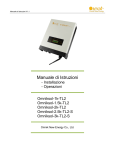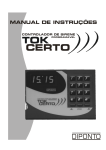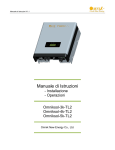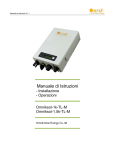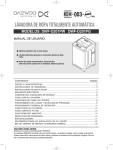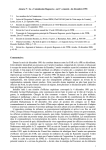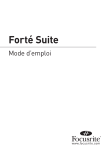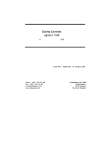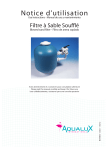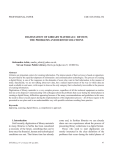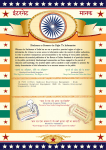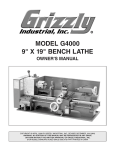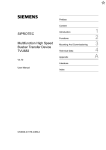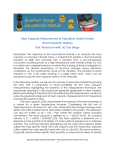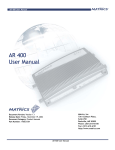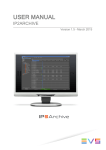Download ORGANIZING AGRICULTURAL LIBRARY COLLECTIONS: .
Transcript
_______________________________________________________________________________________________________ A Working Document n°01 ORGANIZING AGRICULTURAL LIBRARY COLLECTIONS: . DOCUMENTARY CHAIN AND TECHNICAL ACTIVITIES Editors: UMUKAZI Claudine and NSABIMANA Jean-Paul Rubona, 28 January 2009 ISAR: -INSTITUT DES SCIENCES AGRONOMIQUES DU RWANDA -RWANDA AGRICULTURAL RESEARCH INSTITUTE -1- CONTENTS 0. Some explanations I. What is a library-How to start and what we do? II. Technical activities – Books and Journals II.1.Tracing and Selection of Books and Documents II.2. Ordering Procedure II.3. Acquisition Policy II.4. Accessions Book/Accession Number II.5.Ownership Marks II.6. Cataloguing or Bibliographical Description II.7. Classification II.7.1. why is a classification Scheme needed? II.7.2. various classification Systems II.8. Indexing (Geographical Subject Headings) II.9. Computerizing of documents II.9.1. Introduction to CDS/ISIS for windows II.10. Documentary reproduction II.11.Shelving and Binding of Documents II.12. Basic Principles for the Dissemination Selected of Information (DSI) II.13. Managing for Users II.14.Collaboration and Research II.LIST OF USEFUL PUBLICATIONS III.APPENDIX III.A.Sample Library Management Forms -2- Background ISAR, «Institut des Sciences Agronomiques du Rwanda" is Rwanda's only Agricultural Research Institute by mandate. The institute's mission is to generate demand-driven innovative technologies to increase agricultural productivity for food security and improved incomes while conserving the natural resource base. Since its founding in 1963, ISAR has made significant achievements towards improvement of agricultural productivity, especially in the area of crop production. In spite of the huge gains in scientific innovations, the library facilities to support research have not grown in tandem. While big investments have gone into human capacity building and supporting labs, the library upgrading has been left behind. The outdated library is responsible in part for the limited output of publications by the institute staff. The mission of the Library is to support research by identifying, processing and disseminating knowledge generated nationally and internationally. In light of its mission, the library is an important arm of ISAR's new IWM paradigm. The library is expected to facilitate access by scientists to up-to-date literature that will accelerate knowledge and technology dissemination. The library also supports the local community that is engaged in agricultural activities. The current Library is located at ISAR-Rubona, Southern province. The current library accessions are contained in 2,000m3 of space, consisting of monographs, scientific journals, reviews, institute publications, dissertations, training reports, annual reports, pamphlets, posters and electronic documents. Most documents are digitalized with WINISIS software of FAO, though not yet available online. It is planned that all documents should be published on Google. The volume and range of publications and journals that the institute has access to, is too small to enable to institute fulfill its mandate. The demand for library services outstrips its supply capabilities on any given day. The library is funded by Government of Rwanda (GoR) and finds some supports from Agricultural Institutions. It is administrated by Direction of Research authorities at Headquarter, Kigali-Rwanda and has a staff that includes Head of Information, Communication and Documentation, Librarians-technicians, Help-librarians and archivist. UMUKAZI Claudine Head of Information, Communication and Documentation Office -3- Summary This manual has been written to help those who are faced with the task of setting up a small library/documentation centre or who are already working in such a centre, without having learned basic documentation techniques. In particular, it has been developed in response to the needs of librarians in the third World, working in the field of appropriate technology and rural development, with a need for information in a processed form for their daily work. Some people will ask why it is necessary to produce yet another library/documentary manual. Most manual I have come across are too sophisticated, often assuming that the reader is already familiar with basic techniques such as cataloguing. This manual is aimed at librarian’s those who had no formal training in documentation work but who have been assigned to do the library job their organization-be it in their role as secretariat, accountant, engineer or social scientists. It has been written for those who have no access to short-term training courses on library/documentation techniques; for those who do not have the time to study voluminous textbooks on cataloguing and classification and who do not yet have the experience to decide which rules are basic and which ones can be ignored by smaller libraries. In comparison to other currently available manuals on information science and documentation techniques, this guide is very short which an indication that it is far from complete is. It is intended to convey only those basic techniques which the careful reader will be able to use as a starting point? Various terms are currently in use, such as “library”,” documentation centre” documentation unit” Information centre”, or simply “documentation”. Although there is a defined difference between “library” and documentation centre”, the terms are nevertheless used in an almost interchangeable way. We personally think that it does not really matter which descriptive term used-what matters is the quality of the service offered. Since the average no governmental organization or even small governmental organization will have to handle a great variety of publications, it might as well be called a library as a documentation centre. Some people doubt the necessity to organize and manage a small library/documentation centre according to internationally accepted rules. They think it sufficient to shelve the books according to order and that card catalogues are not necessary. They are right as long as the collection does not exceed a total number of approximately 500 copies/entries. Within this range it is still possible to remember the available books and documents and to search for them without losing too much time. But if the collection grows or a change of personal occurs-as is so often the case in small Governmental Organization libraries, it becomes more and more difficult or even impossible to retrieve the information needed within a reasonable period of time. You never know beforehand -4whether and to what extent your library will grow in the future. Therefore, it is advisable to set up even a very small library according to basic international standards as far as cataloguing and classification systems are concerned. These standards will guarantee that any future expansion of the library can be carried out without having to change the whole system. The ISAR library is the focus for this publication, but anyone who is faced with managing a small agricultural library-particularly those in the tropics and those in developing countries –may find this useful. The problems, many of the solutions and the need for support from colleagues in similar situations are the same outside the ISAR. We hope the readers of this manual will be successful in carrying out their important task. If you have any further questions, please do not hesitate to write to: Information, Communication and Documentation Service, ISAR Main Library P.O.Box 138 Butare-Rwanda for further advice. NSABIMANA Jean-Paul Librarian/Technician -5- Acknowledgements The ISAR Main library would like to sincerely thank to the Director General of ISAR, Dr Mark Cyubahiro Bagabe, Deputy Director General of Research, Dr Jonas Mugabe, whom without their moral support and facilitation this work could not been done. Special thanks go to ISAR Staff for their inspiration input, contributions and feedback. Gratitude is to the Centre Technique de Cooperation Agricole et Rural (CTA), The Forum for Agricultural Research in Africa (FARA), Food and Agriculture Organization of the United Nations (FAO) the donor that have made ISAR and its all regional and national activities a reality. -6- 1. Some explanations A library is a place where books and documents are kept. It is a place where documents are arranged, classified, categorized, and indexed by using the international rules. It exists as a resource to answer questions. It is also a beginning to be in research. The library is also used as keyword to disseminate the research results. Organizing and Managing Serials (Journals, Newsletter, Books, Yearbook, Pamphlets) What is a Serial? A Serial is a family of publications that includes journals, newsletters, yearbooks, annual reports, abstracts and indexes, and some publications that look like books, and might be treated as books, but are known as books in series. Before we look at each of these different serials in more detail, perhaps we should explain how books differ from serials: Books are only published once. There may be revisions or new editions, but they still retain that unique quality of being complete. Serials on the other hand, are never complete until they cease to be published. They appear, usually with the same title, periodically, thus they are also sometimes known as periodicals. Serials also carry a numeric description on the front cover, or both, and a date. Types of Serials The most common types of serials are journals and newsletters. A journal is usually an academic publication that prints research articles. The most common format is to publish each issue bimonthly (every two months) or quarterly (every three months). A newsletter is generally a more popular type of publication that can be used to communicate information about the comings and goings of people, new crop practices or pesticides recommendations or whatever the department wants its staff or farmers to know. A yearbook or annual report is published just once a year, and usually describes the work of the proceeding year or years. Abstracting and indexing journals are the most underused resource in a library. Books in series look to all intents and purpose, like books. They have a unique title and publication date. These publications have a volume or issue number, and the cover of each one looks the same, apart from having a unique title and author. They can be handled either as books, or as serials, depending on your priorities. -7- Pamphlets Those original stacks on the floor have migrated to shelves, boxes and bins. We have now dealt with the serials and at least started on the books. What can we said about Pamphlets? - Much of it is short, less than 50 pages - Most of it deals with only a single topic - Much of it is very valuable to users - All of it can be easily stolen - Replacements are almost impossible to find - Frequently the quality of the printing is poor - Identification of the source is often difficult I. What is a library-How to start and what we do? How to start and what to do? Here you are-surrounded by piles of books and documents and you do not know what to do them although you have just been appointed the new librarian/documentalist in Organization. You know that these books have to be put into order-but which system will be best and not too difficult to achieve? You do not even know where and how to start. This manual aims to help you to carry out your seemly impossible task. We are quite confident that you will find after having studied the manual that it is not as difficult as you may have feared. So let us start together from the very beginning. Besides books and documents you will, of course, need a separate library room with basic furniture and equipment. If your organization cannot provide separate room for the library- this may be the case if all of you are working together in one open-plan office-it is advisable to separate a part of the office with shelves and/or desks and tables. - The first step in setting up your library should be to roughly sort the available books and documents according to main subjects. The main subjects should be in accordance with the main tasks of your organization. If you already know which classification scheme you are going to use, you should, of course, use the main groups of that system. -8- II. Technical activities – Books and Journals This documentary chain should help librarians to understand fundamentals notion about organizing and managing of Small Agricultural libraries. II.1.Tracing and Selection of Books and Documents Goal and Process: Documents on specific subjects can be traced through the following information sources: - Special bibliographies - Bibliographies contained in primary documents - Subject specialists - Publishers catalogues - National and international organization and - Other libraries (catalogues and acquisition lists). The best sources of information about new publications are publishers’ catalogues, acquisition lists from other libraries, and book reviews in periodicals. The librarian, too; should regularly and thoroughly scan periodicals, publishers’ catalogues and library acquisition lists for publications of possible use to the library and compile a list of these proposals for the library committee. Check to see if the book in question is distributed free of charge to institutions in developing countries because some international and national development organizations have adopted this practice as part of their information policy. Before submitting the list, the librarian should check each item against the author catalogue and the orders file to ensure that the book is not already in the collection or on order. II.2. Ordering Procedure Goal and Process: There are two ways of acquiring documents: by paying for them or by obtaining them free of charge. Documents we have to pay for can either be ordered at a local bookshop or directly from the publisher. Before placing orders for foreign books with any local bookshop, we make sure that they can handle foreign orders. In addition, once we have decided where to order books, the appropriate addresses have to be located. For quick and easy reference, it is useful to build up an address file of bookshop, publishers and organizations. When parcels of books arrive, the contents are checked against the invoice. The librarian initials the invoice to acknowledge its correctness and passes it on to the Accounts Department for payment. The books are then entered in the accessions books and further processed as described above. -9- II.3. Acquisition Policy Goal and Process: In general, the acquisition policy of an organization depends on a number of factors: - - Budget: The library should allocate a certain amount of money for the purchase of books and periodicals in its annual budget. There is also the possibility that donor agencies give grants for the purchase of foreign books. Objectives and priorities of the parent library. Not everything can or should be acquired. Type of user, users needs. Do the users require scientific materials or simple, practical information? Relationship with other libraries and documentation centers. Library staff. The number of new acquisitions depends also on the number of library staff and their capacity. Languages. A decision is needed regarding the major language of the collection as well as foreign language materials. Acquisition policy is not only related to the books we have to pay for but also those which we are offered free of charge. It often happens that individuals or organizations donate books to library. II.4. Accessions Book/Accession Number Goal and process: All books, documents, studies, reports, etc, should be listed in an accessions book upon receipt. If you are just starting your library/documentation centre, you should list the existing books as the first step in the cataloguing processes. Each book will receive an individual number the accession number. The accession number identifies each book in your library and is particularly useful in distinguishing between multiple copies or different volumes of one title. The accessions book also serves statistical purposes. At any given time you will be able to tell how many books/documents are in the library or, for example, how many books have been received between January and September 2008.In addition, if an important book is lost or has been stolen (which sometimes happens) and an additional copy must be ordered, you can find out where you originally obtained it (the supplier) by looking up the book’s accession number in the accessions book. In the accessions book, the following basic data on a publication will be listed: - Accession number - Date of entry - Author - Title - Supplier (bookseller, supplying organization, donor, editor, date of publication, page) - Code/remarks - 10 - Fig.1. Accessions book II.5.Ownership Marks Goal and Process All books and documents should be stamped with the library stamp in order to identify ownership. The call number and the accession number should also be recorded adjacent to the stamp. The accession number is entered into the book after it has been registered in the accessions book; the call number will be entered after the book has been classified. After having entered the book in the accessions book, you should stamp the title page with the library stamp and write the accession number in its proper place. Fig.2.Library/ownership stamp The library stamp should have approximately the form and size indicated below. If possible, not only the name of the organization but also the address should be given it improves the chances that books will be returned. The call number will be filled in after the main class number of the book has been determined. Now the book is ready for cataloguing! II.6. Cataloguing or Bibliographical Description Goal and Process: Transferring information about a book/document to a card according to set rules is called cataloguing. There are many international and national cataloguing conventions. The most widespread are the “Anglo-American cataloguing Rules (AACR)” to which this manual refers from time to time. - 11 - We do not think it is necessary for a small library to follow all these detailed rules by the letter. However it is necessary to know the basic rules and to stick to them since uniformity is the most important principle in a library. Cataloguing can also be defined by these elements, the catalogue card to which these elements will be transferred and which gives all the information necessary for the complete identification of a work is called identity card. Since this entry also contains information on all other headings under which the work is entered in the catalogue it is also called the main entry card. Its other name is unit card; the basic catalogue card which when duplicated may be used as a unit for all other entries. You may ask yourself why it is necessary to prepare catalogue card, why it is not sufficient to simply put books into order on the shelves. Really, catalogue cards serve to aid the memory of the librarian and the library user. Form of the catalogue card As we have already emphasized, unfortunately is important in library organization. Uniformity is also necessary regarding the form of the catalogue card the way you arrange and type the information describing the elements of a book on the catalogue card. A generally accepted order is outlined below: 1.Author 2.Title -Subtitle -Second and third authors if any or any other information regarding the author/editor -Number of volumes -Edition, reprint 3. Imprint -Place of publication -Name of publisher -Date of publication 4. Collation -Number of pages -Illustration 5. Series and number of series 6. Accession number Fig: Cataloguing card - 12 - II.7. Classification II.7.1. why is a classification Scheme needed? Goal and Process: A library classification is a pre-established scheme which groups concepts/subjects into classes and which uses mostly hierarchical relations for the arrangement of classes: main classes with divisions and subdivisions. A classification scheme provides subject access to the books and at the same time serves to determine particularly the proper location of a publication on the shelves. In classifying, the main class number which corresponds to the main subject of a publication serves at the same time as the call number. A call number is assigned to a book to distinguish it from others and to indicate its place on the shelves. II.7.2. various classification Systems There are basically two types of classification systems: - the universal classification systems and - the special classification systems The universal classification systems cover the whole of human knowledge as represented in books and arrange it in broad subject classes (also called groups). Special classification systems do not claim to cover all knowledge but only the related fields of knowledge in which they specialize. The most widely used universal classification systems in English-speaking countries are: - DEWEY DECEIMAL CLASSIFICATION (DDC) - UNIVERSAL DECIMAL CLASSIFICATION (UDC) - LIBRARY OF CONGRESS CLASSIFICATION (LC) Nevertheless the DDC, which is the most widespread one, shall be briefly outlined in order to demonstrate the structure of universal classification systems. UDC and DDC are very similar in their structure. Otherwise; you could use the following preliminary groups for sorting: - A Agricultural Research E Economics, development and rural sociology F Plant Science and Production H Plant protection J Post harvest technology K Forestry L Animal Science, Production and Protection M Fisheries and Aquaculture N Agricultural machinery and engineering P Natural Resources and Environment Q Processing of agricultural products - - 13 T Pollution U Methodology X others II.8. Indexing (Geographical Subject Headings) Goal and Process: It might be useful and indeed necessary for some organizations to assign geographical subject headings. In such a case we need geographical descriptors as well as descriptors regarding content. As geographical descriptors we should use only those which are already used by large libraries. - The first step is to decide on the descriptors to be used. As it can be assumed that we do not have or need a thesaurus yet, we should use the alphabetical index of our classification scheme. The second step will be to carefully study the publication especially the table of contents in order to ascertain the main subjects. We take the terms we think will be appropriate to cover the content in the best possible way. The third step will be to compare the terms you chose with the descriptors listed in the thesaurus and decide on the most suitable ones. If a book deals with the subject only choose the narrowest term that characterizes the subject. II.9. Computerizing of documents II.9.1. Introduction to CDS/ISIS for windows CDS/ISIS is a menu-driven generalized Information Storage and Retrieval system designed specially for the computerized management of structured non-numerical databases. One of the major advantages offered by the generalized design of the system is that CDS/ISIS is able to manipulate an unlimited number of data bases each of which may consist of completely different data elements. Although some features of CDS/ISIS require knowledge of and experience with computerized information systems, once an application has been designed the system may be used by persons having had title or no prior computer experience. For advanced users CDS/ISIS offers a wide range of programming facility allowing the development of specialized applications through the use of its powerful print formats. For real computer programmes, an external programming library, the ISIS-DILL, provide all necessary tools for developing CDS/ISIS based applications. CDS_I SIS for Wind ows.lnk Goal and Process: This service consists to put the library documents into the data base in orders to search documents using database installed in computer, and then know where they are stocked on shelves. It will also help in knowing how many documents those are available in library. - 14 - The CDS/ISIS database contents much repertory which facilitates in accessing of library data and encoding new documents: - C:\winisis\data\inwork.mst EMONO for monographs EMCHP for chapters/conference paper EARTI for articles This service has been successfully by utilization of database software such as CDS/ISIS for Windows from UNESCO and User’s manual: MUSALIT of INIBAP. Lastly, all documents that are registered in database must have a sign on cover page ‘BIBCENTRISAR’ II.10. Documentary reproduction Goal and Process The Library assists to the compilation of Institutional publications of research results like, books, yearbook or annual report, Proceedings of meeting, and other publication such as leaflets, indexes and bibliographical references that require certain facilities. A bibliographic service can enhance institutional performance and can be a motivation of scientists to publish. In particular, this Service needs continuously updated database supporting software such as WINISIS, which ISAR uses. - 15 - II.11.Shelving and Binding of Documents Goal and Process: The processed books and documents will be arranged on the shelves according to their call number, class numbers and within each class number in alphabetical order according to the author’s name. But the books and documents with small size and volumes are arranged into the boxes that they have been called “Separata” II.12. Basic Principles for the Dissemination Selected of Information (DSI) Goal and Process: 1. Know the users and their needs and provide and disseminate information accordingly. This involves talking to users, knowing what they are presently working on, and knowing their fields of interest. Only then can advise them well and refer them to new and interesting publications that they may not have asked for and that perhaps they were not even aware of. On the other hand, the user may give we valuable advice on the existence and quality of new publications. A good relationship between the librarian and the user benefits both. 2. The library should be organized in such a way that it invites the readers to browse through the collection. The layout of the library should be logical, the labeling of the shelves should be clearly recognizable, and the classification scheme should be prominently displayed, and should be a work area for the use of the readers-in a word: the atmosphere should be inviting. On entering the library, the user should have the feeling of being welcomed, of not being an intruder. The librarian should help the users to overcome the fear of entering a strange place. We can do so by giving each newcomer a brief personal introduction and/or by preparing a leaflet explaining the system applied and the services offered, i.e. how to use a catalogue, how to find a subject in the classification scheme, how to make best use of the various files, etc. The loan policy should be flexible, not restrictive. 3. Provide good reference services. Keep your collection up to date. Make sure that books often required are actually available, i.e. reference books, maps, basic handbooks, etc., should not be borrowed. Books frequently required are to be lent out for a short period only and/or a second copy should be provided. An accession list should be prepared at regular intervals to inform the users about new books acquired by the library. The opening hours should be regular and as long as possible. - 16 - II.13. Managing for Users Goal and Process: This service consists to control the movement of library documents, the reason why they are rules and conditions for lending and borrowing of documents. It is free to visit the ISAR library, and but it necessity the better arrangement for good management of users in which we look at space for reading, Space for shelves, Space for periodicals, Place for multimedia service (where the CD-ROM, DIVD, ICT equipment are stocked),Archive section (Space for underutilized documents) and Computer Lab. II.14.Collaboration and Research Goal and Process The library creates and improves relationships with other documentary centers for more support and help in and outside of country. It is done as Questions and Answers Services (QAS) in which we found the challenges objectives: - Provide stakeholders, especially farmers and fishermen, timely and cost-effective access to agricultural information Increase the efficiency and effectiveness of information support service to agricultural and rural development through QAS activities Sustain and create awareness of QAS activities among the district agricultural information centers Collaborate with documentary centers to reach a broader audience of farmers with answers to frequently asked questions Identify relevant information products, particularly publications on new technologies, and repackage them for extension workers for the benefit of farmers Strengthen the capacity of the Coordinating Centre and the participating institutions to sustain the service Correspondence with Scientifics editors - 17 - II.LIST OF USEFUL PUBLICATIONS 1. Foss, P.D and al. (1991).-Organizing agricultural library collections: A Workbook, CTA, IRETA, SPC, 93 p. 2. None ( ).-Manuel de reference sur CDS/ISIS for Windows, UNESCO, 152 p. 3. Maniez, J. (1987).-Les langages documentaires et classificatoires: Conception, construction et utilisation dans les systèmes documentaires, Les éditions d’Organisations, Paris, 291 p. 4. Vernon, R. (2001).-Knowing where you’re going: Information Systems for Agricultural Research Management, CTA, and ISNAR345 p. 5. Dulong, A. (1977).-Manuel du Bibliothécaire documentaliste dans les pays en développement, Agence de Coopération Culturelle et Techniques, Paris, France, 459 p. 6. Guinchat, C. et al. (1990).-Introduction générale aux Sciences et techniques de l’Information et de la Documentation, UNESCO, Paris, France, 543 p. 7. The Chicago: Manuel of style: The 13th Edition of A Manual of Style Revised and Expanded, 738 p. - 18 - III.APPENDIX III.A.Sample Library Management Forms User Interlibrary Loan Request Form: Book Pocket Book Circulation Card ISAR Borrower’s name:……………………….. Station:……………………………………. Programme:…………………………….. Address:……………………….. Author Title Code Date due Signature Date of Signature return - 19 - Reserve Book Card ISAR Main Library Title: ______________________________________________________________________________ __________________________________________________________________________ Accession number Code: NAME EXIT ENTRY Bulletin cards for journals or periodicals ISAR Journal title:______________________________________________________________ Editors:___________________________________________________________________ Parution:__________________________________________________ Year Volume Issue Date of publication Date of Entry - 20 - Card catalogue ISAR Author_____________________________________________________________________ Title________________________________________________________________________ Place of publication_____________________________Publisher___________________ Date___________________Edition_______________________ Series______________________________________________________________________ Volume number_____________________ Pages_________________________________ Reference Statistics for frequentation ISAR Period:………/……./…… to ……/……/……. UNIT PROGRAMME Banana Bean Horticulture Coffee CAS Livestock Agro forestry Sorghum Maze Sweet potato Cassava PHU TTU Wheat Labs Crop protection Rice Biotechnology Tea In vitro Visitors Students Administrative Monday Tuesday Wednes. Thurs. Friday - 21 - Questions and Answers Form ISAR INFORMATION REQUEST FORM It is now easier for you to get access to any information using QAS service which aims at providing support to the stakeholders of research and development through provision of specialized information. Please fill in this form carefully and return it to the main library of ISAR _____________________________________________________________________________ Full name:…………………………………………Function……………………………………… Organization……………………………………..Department/Programme:………………….. Address:………………………………. 1. Are you involved in any activity related research and development? Yes or No 2. What do you understand by a library? -A place where books are kept -A place where books are read silently -A place where to search information from 3. To which extent the following information support tools are important to you? -Books -Periodicals -Annual Reports -Proceedings -Grey literature -Data beses -CD-ROMs Very important Important Not important ………………. ………….. ……………….. ………………. ………….. ………………. ………………. …………. ……………….. ………………. …………. ………………. ……………… …………. ………………. ……………… ………….. ………………. ……………… …………. ……………… 4. How many times do you visit the library? 5. When you visit the library, does the librarian attend to you quickly? Yes or No 6. What do you think should be done in the library so that you receive better services? 7. What are the top three problems you encounter when you visit the library? 8. What are the top three library services that you use in the library? -Reference services -Library catalogue or index 9. What services would you like to see the library offer in addition to what they are already offering? 10. What other information material should be added in the library? - 22 - III.B. Acronyms and Abbreviations AGRIS: International Information System for Agricultural Sciences and Technology (FAO) AGROVOC: An Agricultural thesaurus developed by FAO CARIS: Current Agricultural Research Information system (FAO) CDS/ISIS: Bibliographic software developed by UNESCO CD-ROM: Compact disc/Read only memory-A computer storage medium FAO: Food and Agriculture Organization (UN, based in Rome) INIBAP: International Network for the Improvement of Banana and plantain ISAR: Institut des Sciences Agronomiques du Rwanda III.C.Grossary - - Accession number. A number assigned to each book as it is received in the library, Accession book. The book in which all books and documents are entered immediately after receipt.Nonbook materials are entered in the accessions book for no book materials. Acquisition policy. The policy pursued in obtaining new materials for a collection Author. The person or corporate body responsible for the content of a publication writer of a book, compiler of a bibliography, artist, photographer, etc. Author catalogue. A card catalogue of author entries, arranged alphabetically, usually including added entries under editors, second and third authors, etc., and entries under titles in the case of anonymous works. Bibliography. A list of books, periodicals, or other works Call number. The notation used to identify and locate a particular book on the shelves. It consists of the classification number and the first three letters of the author’s name. Catalogue. A list of books, maps, journals, recordings or any other medium that comprises a collection. Collation. Physical description of a book. It consists of the number of pages, presence of illustrations (maps,tables,graphs,charts,figures),bibliography, and appendices Collection. A group of books or other materials; also used for the library’s entire holdings. Compiler. One who bring together written or printed matter from the works of various authors or the works of a single author, for instance the compiler of a bibliography. Descriptors: Clearly defined term of thesaurus or any list of controlled vocabulary used as subject heading Monograph. A complete bibliographic unit. It may be a single work or a collection that is not a serial Thesaurus. A collection of descriptors generally within a special field of knowledge which not only lists the terms in alphabetical order but also displays their relationship. Similar to lists of subject headings.
























